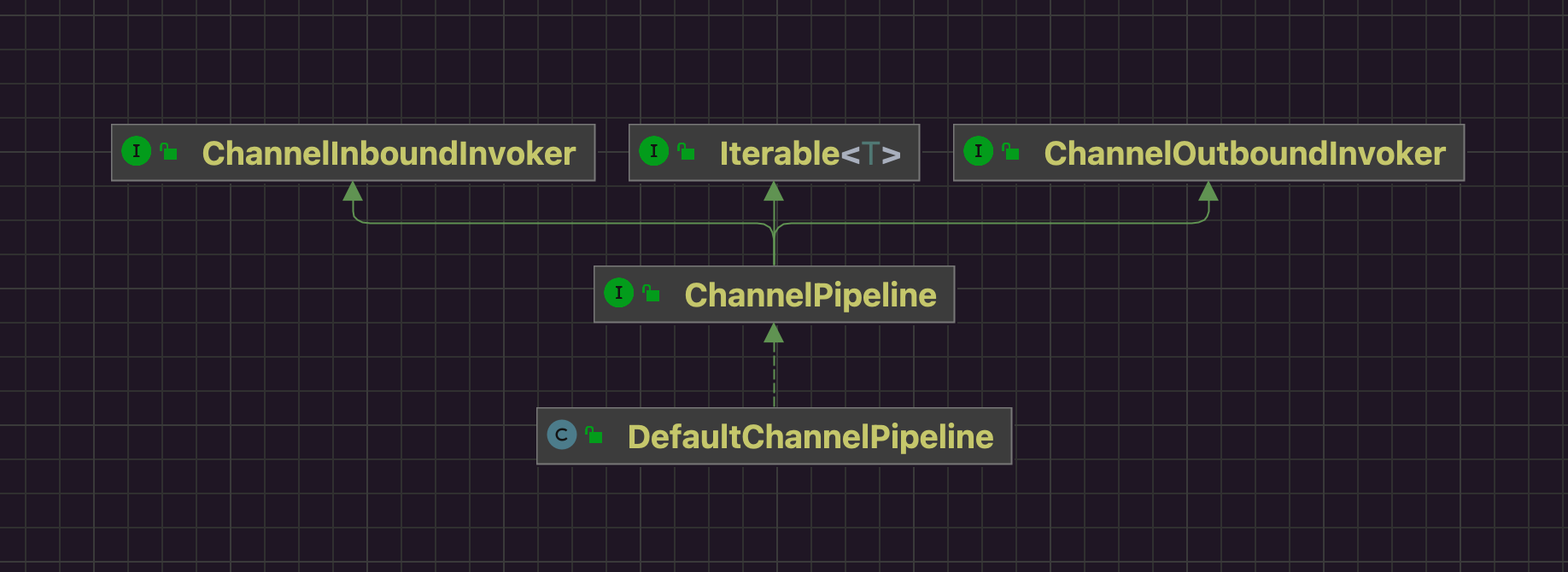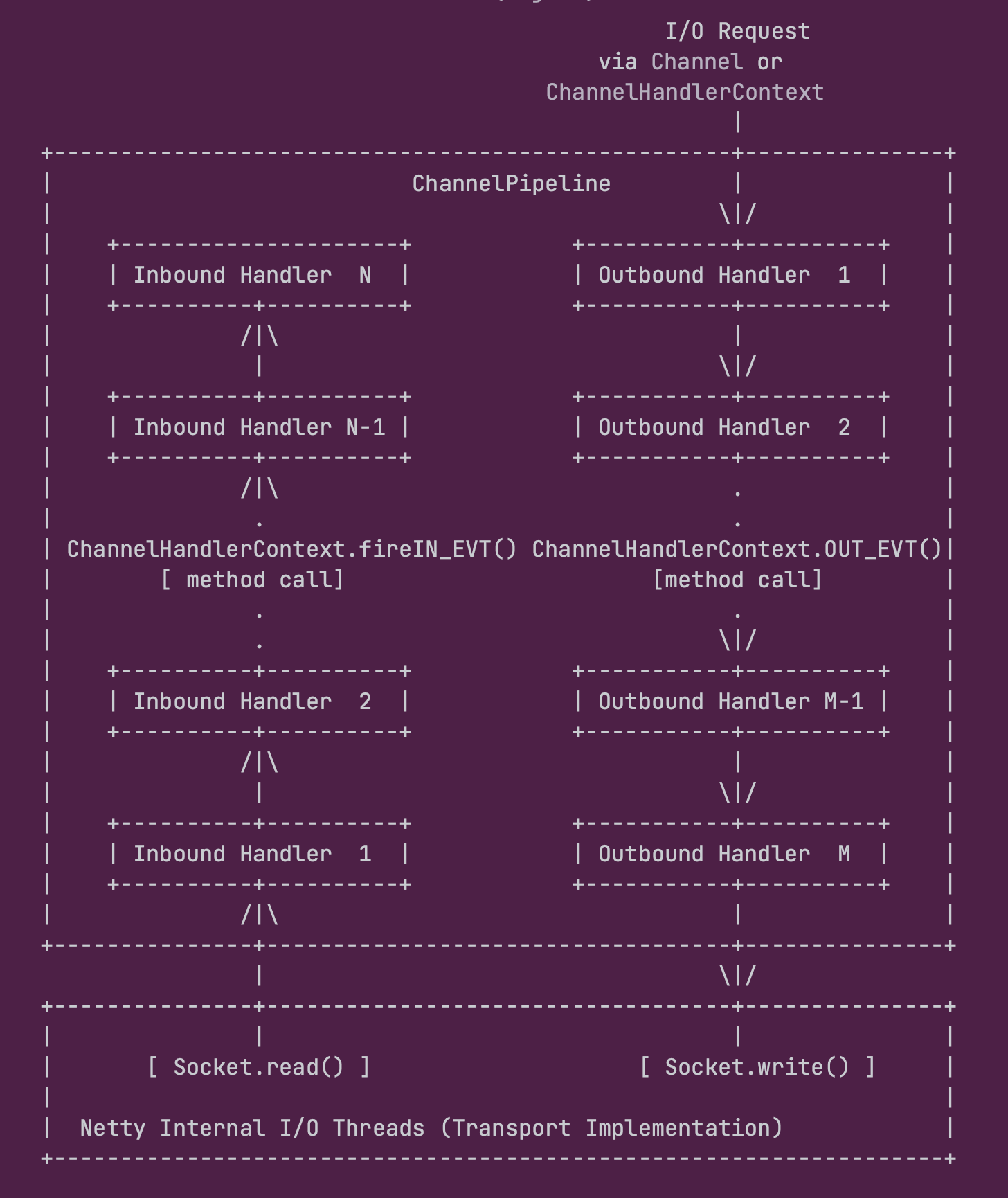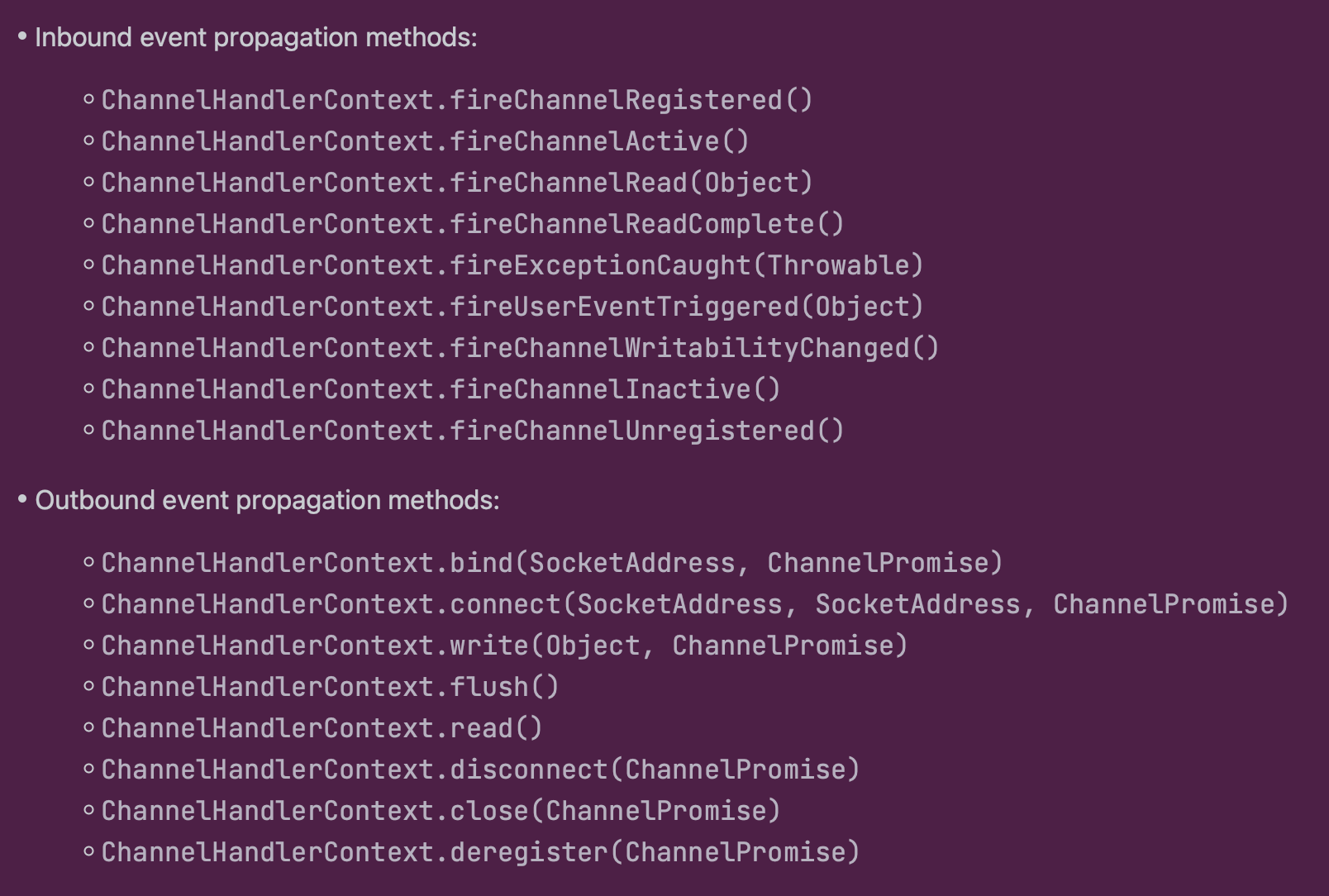在Channel的初始化过程中会给每个Channel实例构造一个Pipeline,因此研究pipeline的入口就是构造方法。
一 类图
是继承关系上看,pipeline的实现比较简单。

二 JavaDoc

Netty采用Reactor的线程模型,一个IO线程负责读写,至于怎么操作读写的逻辑则定义在不同的handler中,pipline就是handler的栖身之所,pipeline负责组织和管理着。
将数据流转抽象定义为:
- 入站 从Socket流向Netty的Channel。
- 出站 从Netty的Channel流向Socket。
三 Demo
1
2
3
4
5
6
7
8
9
10
11
12
13
14
15
16
17
18
19
20
21
22
23
24
25
26
27
28
29
30
31
32
33
34
35
36
37
38
39
40
41
42
43
44
45
46
47
48
49
50
51
52
53
54
55
56
57
58
59
| package io.netty.example.basic.pipeline;
import io.netty.channel.ChannelHandlerContext;
import io.netty.channel.ChannelInboundHandlerAdapter;
import io.netty.channel.ChannelOutboundHandlerAdapter;
import io.netty.channel.embedded.EmbeddedChannel;
public class PipelineTest00 {
public static void main(String[] args) {
EmbeddedChannel ch = new EmbeddedChannel();
ch.pipeline()
.addLast(new ChannelInboundHandlerAdapter() {
@Override
public void channelRead(ChannelHandlerContext ctx, Object msg) throws Exception {
System.out.println("1");
ctx.fireChannelRead(msg);
}
})
.addLast(new ChannelOutboundHandlerAdapter() {
@Override
public void read(ChannelHandlerContext ctx) throws Exception {
System.out.println("2");
ctx.read();
}
})
.addLast(new ChannelInboundHandlerAdapter() {
@Override
public void channelRegistered(ChannelHandlerContext ctx) throws Exception {
System.out.println("3");
ctx.fireChannelRegistered();
}
})
.addLast(new ChannelOutboundHandlerAdapter() {
@Override
public void read(ChannelHandlerContext ctx) throws Exception {
System.out.println("4");
ctx.read();
}
})
.addLast(new ChannelInboundHandlerAdapter() {
@Override
public void channelRead(ChannelHandlerContext ctx, Object msg) throws Exception {
System.out.println("5");
ctx.fireChannelRead(msg);
}
});
System.out.println("入站");
ch.pipeline().fireChannelRead("");
System.out.println();
System.out.println("出站");
ch.pipeline().read();
}
}
|
从demo的输出直观看出:
- 入站事件 pipeline从head发布事件->tail。
- 出站事件 pipeline从tail发布事件->head。
四 构造方法
1
2
3
4
5
6
7
8
9
10
11
12
13
14
15
16
17
18
19
20
21
|
protected DefaultChannelPipeline(Channel channel) {
this.channel = ObjectUtil.checkNotNull(channel, "channel");
succeededFuture = new SucceededChannelFuture(channel, null);
voidPromise = new VoidChannelPromise(channel, true);
tail = new TailContext(this);
head = new HeadContext(this);
head.next = tail;
tail.prev = head;
}
|
内部就是一条双向链表,对于hanlder本身标识它对入站事件还是出站事件感兴趣,然后来了事件就顺着链表以职责链设计模式走一遍,哪个handler感兴趣就自己触发回调。
- 入站事件 从head->tail走一遍。
- 出站事件 从tail->head走一遍。
pipeline并没有将handler直接组织成双链表的节点,而是将handler封装成了HandlerContext。
而二者的区别在于:
- Handler - 执行逻辑处理。
- HandlerContext - 干预事件传播机制。
1 HeadContext
1
2
3
4
5
6
|
HeadContext(DefaultChannelPipeline pipeline) {
super(pipeline, null, HEAD_NAME, HeadContext.class);
unsafe = pipeline.channel().unsafe();
setAddComplete();
}
|
2 TailContext
1
2
3
4
5
6
7
8
9
|
TailContext(DefaultChannelPipeline pipeline) {
super(pipeline, null, TAIL_NAME, TailContext.class);
setAddComplete();
}
|
3 AbstractChannelHandlerContext
怎么标识一个handler是属于入站还是出站就是通过这个executionMask来体现的。
1
2
3
4
5
6
7
8
9
10
11
12
13
14
15
16
|
private final int executionMask;
AbstractChannelHandlerContext(DefaultChannelPipeline pipeline, EventExecutor executor, String name, Class<? extends ChannelHandler> handlerClass) {
this.name = ObjectUtil.checkNotNull(name, "name");
this.pipeline = pipeline;
this.executor = executor;
this.executionMask = mask(handlerClass);
ordered = executor == null || executor instanceof OrderedEventExecutor;
}
|
通过位运算便可以组合出每个handler的感兴趣事件集合,来标榜每个handler是属于入站类型还是出站类型。
1
2
3
4
5
6
7
8
9
10
11
12
13
14
15
16
17
| static final int MASK_EXCEPTION_CAUGHT = 1;
static final int MASK_CHANNEL_REGISTERED = 1 << 1;
static final int MASK_CHANNEL_UNREGISTERED = 1 << 2;
static final int MASK_CHANNEL_ACTIVE = 1 << 3;
static final int MASK_CHANNEL_INACTIVE = 1 << 4;
static final int MASK_CHANNEL_READ = 1 << 5;
static final int MASK_CHANNEL_READ_COMPLETE = 1 << 6;
static final int MASK_USER_EVENT_TRIGGERED = 1 << 7;
static final int MASK_CHANNEL_WRITABILITY_CHANGED = 1 << 8;
static final int MASK_BIND = 1 << 9;
static final int MASK_CONNECT = 1 << 10;
static final int MASK_DISCONNECT = 1 << 11;
static final int MASK_CLOSE = 1 << 12;
static final int MASK_DEREGISTER = 1 << 13;
static final int MASK_READ = 1 << 14;
static final int MASK_WRITE = 1 << 15;
static final int MASK_FLUSH = 1 << 16;
|
上面这些枚举也对应着每个API,也可以直接看JavaDoc的说明:

五 入站事件
比如ChannelRead属于入站事件。
1
2
3
4
5
6
7
8
9
10
11
12
13
|
@Override
public final ChannelPipeline fireChannelRead(Object msg) {
AbstractChannelHandlerContext.invokeChannelRead(head, msg);
return this;
}
|
1
2
3
4
5
6
7
8
9
10
11
12
13
14
15
16
|
static void invokeChannelRead(final AbstractChannelHandlerContext next, Object msg) {
final Object m = next.pipeline.touch(ObjectUtil.checkNotNull(msg, "msg"), next);
EventExecutor executor = next.executor();
if (executor.inEventLoop())
next.invokeChannelRead(m);
else {
executor.execute(new Runnable() {
@Override
public void run() {
next.invokeChannelRead(m);
}
});
}
}
|
1
2
3
4
5
6
7
8
9
10
11
12
| private void invokeChannelRead(Object msg) {
if (invokeHandler()) {
try {
((ChannelInboundHandler) handler()).channelRead(this, msg);
} catch (Throwable t) {
this.invokeExceptionCaught(t);
}
} else {
fireChannelRead(msg);
}
}
|
1
2
3
4
5
|
@Override
public void channelRead(ChannelHandlerContext ctx, Object msg) {
ctx.fireChannelRead(msg);
}
|
1 HandlerContext处理事件
HandlerContext本身组合了handler,所以可以执行处理逻辑。
2 HandlerContext干预事件传播
1
2
3
4
5
6
|
@Override
public ChannelHandlerContext fireChannelRead(final Object msg) {
this.invokeChannelRead(this.findContextInbound(MASK_CHANNEL_READ), msg);
return this;
}
|
HandlerContext处理完逻辑之后还可以决定是否将事件继续传播下去,还是到此为止。
然后就是周而复始:
- invokeChannelRead
- channelRead
- fireChannelRead
每个入站处理器的逻辑都定义在channelRead(…)被回调,在fireChannelRead向后传播。
从入站事件传播就可以推出来出站事件的逻辑:
- pipline发布的出站事件以tail为起始点,开始传播
- 每个处理器处理完回调逻辑,继续顺着tail->head的方向传播事件
六 出站事件
比如Read属于出站事件。
1
2
3
4
5
6
7
8
9
10
11
12
13
|
@Override
public Channel read() {
pipeline.read();
return this;
}
|
1
2
3
4
5
6
7
8
9
10
11
12
13
|
@Override
public final ChannelPipeline read() {
tail.read();
return this;
}
|
1
2
3
4
5
6
7
8
9
10
11
12
13
14
15
16
17
18
|
@Override
public ChannelHandlerContext read() {
final AbstractChannelHandlerContext next = findContextOutbound(MASK_READ);
EventExecutor executor = next.executor();
if (executor.inEventLoop()) {
next.invokeRead();
} else {
Tasks tasks = next.invokeTasks;
if (tasks == null) {
next.invokeTasks = tasks = new Tasks(next);
}
executor.execute(tasks.invokeReadTask);
}
return this;
}
|
1
2
3
4
5
6
7
8
| private AbstractChannelHandlerContext findContextOutbound(int mask) {
AbstractChannelHandlerContext ctx = this;
EventExecutor currentExecutor = executor();
do {
ctx = ctx.prev;
} while (skipContext(ctx, currentExecutor, mask, MASK_ONLY_OUTBOUND));
return ctx;
}
|


